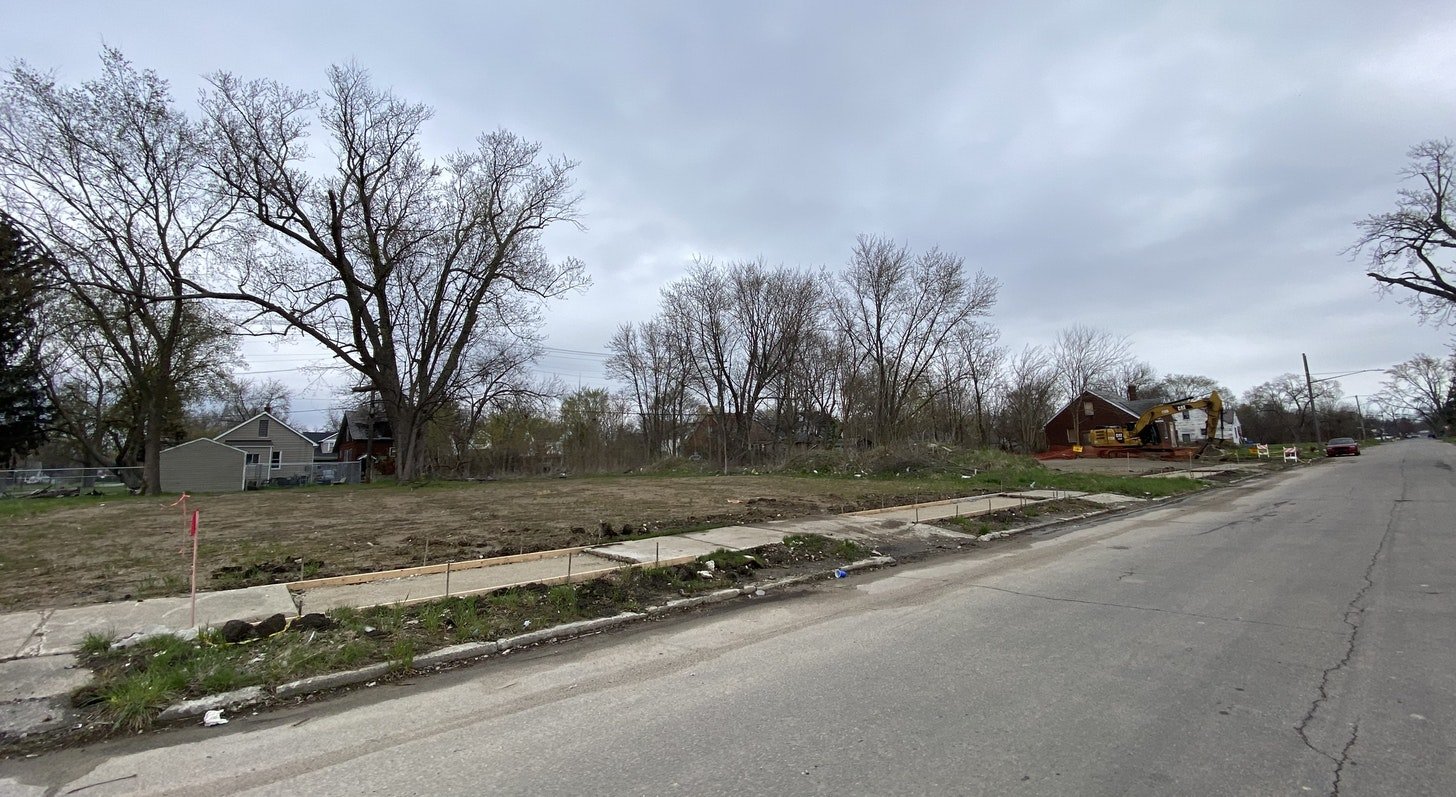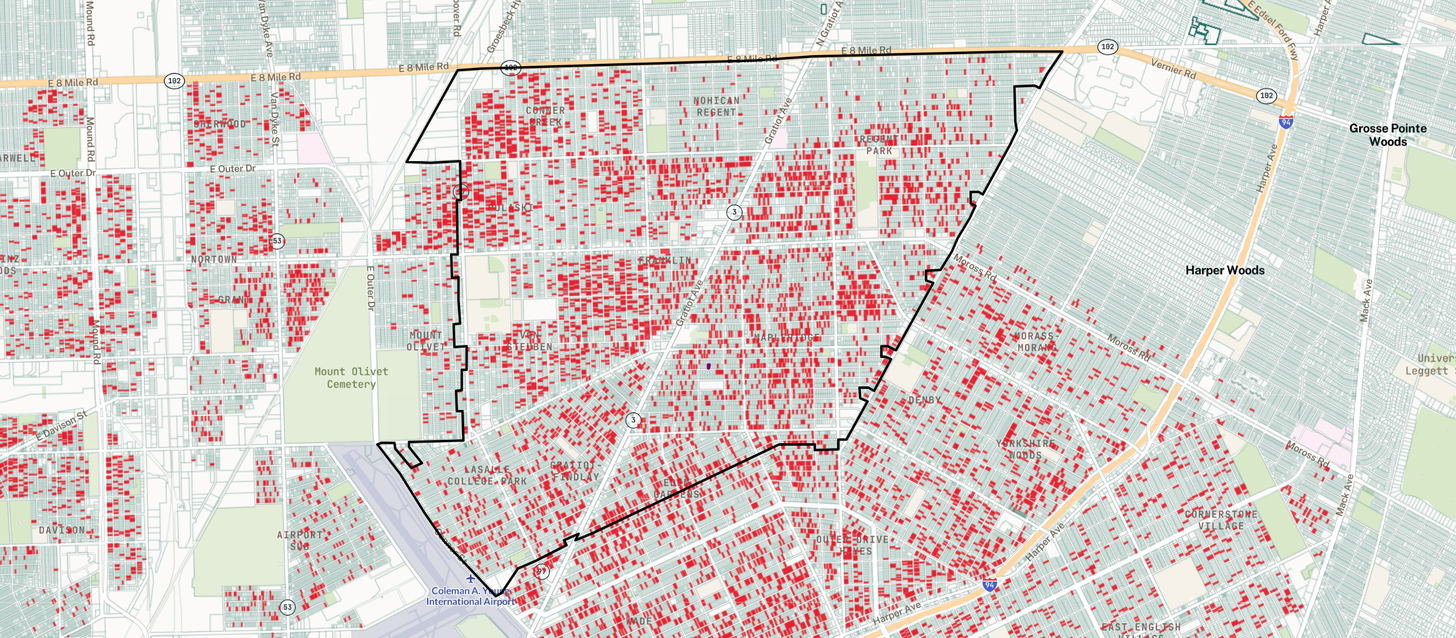An Epidemic of Blight Collides With a Pandemic
This article was originally published, in slightly different form, on Alex Alsup’s Substack, The Chargeback. It is shared here with permission. All images for this piece were provided by the author.
One of the most important streets in Detroit, to me, used to be the block of Hazelridge Street between Celestine and MacCrary.
The street is in northeast Detroit, in the city’s 48205 zip code. 48205 is probably one of the most distressed zip codes in the country over the last 20 years, thanks to two decades of unrestrained tax foreclosures of homeowners in poverty, rampant property speculation from suburban tax auction buyers, unmitigated evictions, deterioration of housing conditions due to lack of repair funds, and landlords uninterested in maintaining their properties—to name a few of the perpetual housing crises that have confronted residents in the area.
I used to visit the Hazelridge Street regularly because, even though there had been only one occupied home on the block for years, just about all the other houses were still standing, despite being vacant:
Hazelridge Street between Celestine and MacCrary via Google Street View Time Machine on my website, GooBing Detroit.
It was an unavoidable record of what happened to the neighborhood. You couldn’t not see the vacant houses (except when completely overgrown in the summer) and an impression of what used to be there. Couldn’t avoid asking what happened and why.
Here’s what that stretch of Hazelridge Street, above, looked like in May 2022 after ten years of demolition activity across the city:
Hazelridge Street between Celestine and MacCrary, May 2022.
During Motor City Mapping in the winter of 2013 and 2014, a citywide property condition survey commissioned by the Blight Task Force during Detroit’s bankruptcy, which I worked on as part of the Loveland Technologies team (now Regrid), I suggested to a New York Times reporter in town to cover the effort to interview Karl Baker, who lived in the last occupied house on that block of Hazelridge Street.
The reporter, Monica Davey, interviewed Mr. Baker for her front page story on Motor City Mapping, “A Picture of Detroit Ruin, Street by Forlorn Street”:
Blight, as Karl Baker, one Detroit resident, has seen, tends to spread. Along his block of Hazelridge Street on the East Side, he is the only remaining tenant. “Everyone went bye-bye,” Mr. Baker said the other day as he walked up the center of the silent street to get to his house since no sidewalks had been shoveled.
Mr. Baker seemed to understand blight better than most: as a symptom.
Two Eras in the 48205 Zip Code
1. Pre-Pandemic Era
When Motor City Mapping ended in March 2014, property canvassers with the project had identified 4,064 vacant homes in the 48205 zip code.
Vacant homes in Detroit’s 48205 zip code as identified in Motor City Mapping circa 2014.
From the end of Motor City Mapping in March 2014 until January 2020, just before the start of the coronavirus pandemic, $25 million was spent on the demolition of 1,628 homes in the 48205 zip code, per records on completed residential demolitions from the City of Detroit’s open data portal.
Had no additional homes gone vacant between March 2014 and January 2020, nor any vacant homes been reoccupied (neither is a reasonable thing to expect, but, for the sake of argument), then by January 2020 those demolitions would have produced a 40% decline in the number of vacant homes in the 48205 zip code.
Instead, comparing residential vacancy data from January 2020 (data maintained by Regrid and derived from the U.S. Postal Service) to Motor City Mapping data from March 2014 shows just a 2% decrease in the total number of vacant homes: From 4,064 vacant homes in March 2014, to 3,986 in January 2020.
Why did 1,600+ demolitions of vacant homes reduce the total number of vacant homes in the 48205 zip code by less than 100? Because between 2014 and 2020, 1,941 homes that had been occupied in 2014 went vacant, outpacing the demolition of those 1,628 vacant homes.
At Regrid we have a monthly snapshot of residential vacancy as recorded by the U.S. Postal Service for the entire country dating back to early 2019. The data provides a fascinating picture of changes in residential vacancy from just before the pandemic through the present day. While we have seen significant changes in residential vacancy data nationally, Detroit is certainly among the most striking.
The vacancy data circa 2020 doesn’t conflict with my observations of the 48205 zip code over the last ten years. Nor does it conflict with the visual evidence offered by Google Street View Time Machine imagery of the properties that were occupied in March 2014 (per Motor City Mapping data) and then vacant in January 2020 (per Regrid’s USPS data):
What Happened?
Demolitions may have started in 2014, but the “unrestrained tax foreclosures of homeowners in poverty, rampant property speculation from suburban tax auction buyers, unmitigated evictions, deterioration of housing conditions due to lack of repair funds, and landlords uninterested in maintaining their properties” didn’t end.
Blight—an end stage symptom of those systems—continued to spread.
For instance, of the 1,941 homes that went vacant in the 48205 zip code from 2014 to 2020, 60% (1,164) were in a tax foreclosure auction in that timespan. You don’t need to look a whole lot further than that to identify a major generator of new vacancy.
In the Blight Task Force report, published after Motor City Mapping in 2014, we warned of this:
Even the swiftest and most aggressive fight against today’s blight will accomplish very little if we don’t address the conditions that led to it…
Without intervention, county tax foreclosure will continue to sweep across the city until the inventory of foreclosable properties is exhausted. Speculators will buy cheap property and allow it to deteriorate. Despairing and frustrated residents will continue to walk away from their tax foreclosed homes and from Detroit. Unscrupulous landlords will evict tenants and scrap their own properties.
2. The Pandemic Era
At the start of the pandemic, I worried the worst still lay ahead for areas like the 48205 zip code. How could you imagine anything else as deaths mounted across the city and the country? But the pandemic brought changes that drastically altered the housing trajectory for the country, the city of Detroit, and even the 48205 zip code.
Understand what’s causing the housing challenges in your city, and how to change them for the better.
Take our course, “Creating Housing Opportunities in a Strong Town,” over at the Strong Towns Academy.
First, policies changed rapidly. There were local, state, and federal moratoriums on evictions, tax foreclosures, and water shutoffs. Stimulus checks and other benefits changed the financial picture for residents with low incomes. The systems that caused blight and vacancy were silenced, temporarily.
Second, neither Detroit nor the 48205 zip code has been immune to the soaring national demand for housing. There’s been evidence of in-migration to the Detroit metro area, and Detroit itself, amidst the pandemic, further boosting local demand for housing.
In the 48205 zip code, absent the systems that generated blight and vacancy, occupied homes remained occupied—new vacancies slowed. Not only that, voracious demand for housing meant that long-vacant homes, homes for which there was no market just three years ago, began to be snapped up by investors, rehabbed, and rented out.
By May 2022, the January 2020 figure of 3,986 vacant homes in the 48205 zip code dropped to 2,965 vacant homes—a 26% decline in the number of vacant homes in the zip code in less than 2.5 years.
But it was not, primarily, demolitions that reduced the number of vacant homes. Instead, the decline was driven by vacant homes being rehabbed and reoccupied.
446 homes were demolished in the 48205 zip code between January 2020 and May 2022, but Regrid’s USPS Vacancy Data shows that 1,004 vacant homes were reoccupied in the same timeframe.
Again, evidence of homes rehabbed & reoccupied in the 48205 zip code amidst the pandemic isn’t hard to find via Google Street View and, this time, the City of Detroit’s own, fantastic, street view program (as it has imagery from 2022) published via Mapillary:
Today
The pandemic forced policymakers to, momentarily, move beyond treating the symptoms of blight and confront underlying causes of housing instability—things like tax foreclosures and evictions. It would have looked ridiculous to respond to a pandemic by insisting to knock down more vacant houses, faster.
The pandemic may have put things in starker relief, but it has always been the case that treating the end stage symptoms of tax foreclosure and eviction by demolishing the consequences of those systems and expecting that would somehow stop new vacant homes from popping up, or make highly distressed neighborhoods more desirable, makes no sense.
1,600 demolitions in the 48205 zip code didn’t reduce the number of vacant homes. And yet when market demand for housing soared, the presence of those vacant homes proved not to be a deterrent, either. Rehab cost figures that didn’t work in 2019 suddenly worked in the market of 2021 and the homes got rehabbed.
We should regret demolishing as much as we have. How many homes looked unviable in 2016 market terms that, today, would have been eagerly rehabbed, absorbing housing demand?
Moreover, we should absolutely regret that tax foreclosures and evictions weren’t stopped sooner—as there’d be less of a need to rehab destroyed homes so they can be rented back to the families of the people who used to own them.
Tomorrow
The moratoriums that were so beneficial have largely ended at this point. But beyond the immediate benefits they provided, they also created breathing room. Without the pressure of constant evictions and annual tax foreclosure auctions, it was possible to focus on reform.
In tax foreclosure, Pay As You Stay was passed into law, creating a way for homeowners in poverty to retroactively cancel the majority of their property tax debt. The Detroit Tax Relief Fund was created to pay off whatever remained. A right to counsel ordinance was passed by Detroit’s city council and a fund established to pay for representation of tenants facing eviction. New, better-funded repair programs will address more housing conditions. These are all much more potent tools to fight back what ravaged areas like the 48205 zip code from 2014 to 2020.
And yet, we’re clearly in an era of high volatility and uncertainty. The threats that distressed areas like the 48205 zip code faced in years past may not be the same as the ones they face in years to come.
Whatever comes next, if we don’t want to relive the mistakes and futile policies of 2014–2020, we’re going to have to figure out the difference between treating symptoms and addressing causes.
Alex Alsup is the Vice President of Research & Development at Regrid. He leads Regrid’s Data With Purpose program which makes the company’s nationwide parcel boundary geometry and data available for research and non-profit purposes. Alex lives in Detroit and can be followed on Twitter and Substack.











